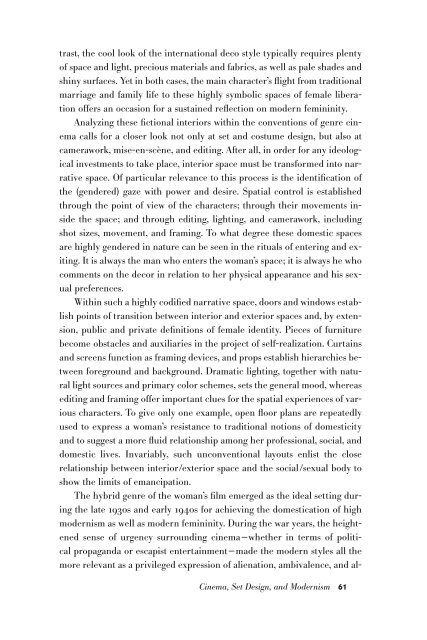Create successful ePaper yourself
Turn your PDF publications into a flip-book with our unique Google optimized e-Paper software.
trast, the cool look of the international deco style typically requires plenty<br />
of space and light, precious materials and fabrics, as well as pale shades and<br />
shiny surfaces. Yet in both cases, the main character’s flight from traditional<br />
marriage and family life to these highly symbolic spaces of female liberation<br />
offers an occasion for a sustained reflection on modern femininity.<br />
Analyzing these fictional interiors within the conventions of genre cinema<br />
calls for a closer look not only at set and costume design, but also at<br />
camerawork, mise-en-scène, and editing. After all, in order for any ideological<br />
investments to take place, interior space must be transformed into narrative<br />
space. Of particular relevance to this process is the identification of<br />
the (gendered) gaze with power and desire. Spatial control is established<br />
through the point of view of the characters; through their movements inside<br />
the space; and through editing, lighting, and camerawork, including<br />
shot sizes, movement, and framing. To what degree these domestic spaces<br />
are highly gendered in nature can be seen in the rituals of entering and exiting.<br />
It is always the man who enters the woman’s space; it is always he who<br />
comments on the decor in relation to her physical appearance and his sexual<br />
preferences.<br />
Within such a highly codified narrative space, doors and windows establish<br />
points of transition between interior and exterior spaces and, by extension,<br />
public and private definitions of female identity. Pieces of furniture<br />
become obstacles and auxiliaries in the project of self-realization. Curtains<br />
and screens function as framing devices, and props establish hierarchies between<br />
foreground and background. Dramatic lighting, together with natural<br />
light sources and primary color schemes, sets the general mood, whereas<br />
editing and framing offer important clues for the spatial experiences of various<br />
characters. To give only one example, open floor plans are repeatedly<br />
used to express a woman’s resistance to traditional notions of domesticity<br />
and to suggest a more fluid relationship among her professional, social, and<br />
domestic lives. Invariably, such unconventional layouts enlist the close<br />
relationship between interior/exterior space and the social/sexual body to<br />
show the limits of emancipation.<br />
The hybrid genre of the woman’s film emerged as the ideal setting during<br />
the late 1930s and early 1940s for achieving the domestication of high<br />
modernism as well as modern femininity. During the war years, the heightened<br />
sense of urgency surrounding cinema—whether in terms of political<br />
propaganda or escapist entertainment—made the modern styles all the<br />
more relevant as a privileged expression of alienation, ambivalence, and al-<br />
Cinema, Set Design, and Modernism 61

















